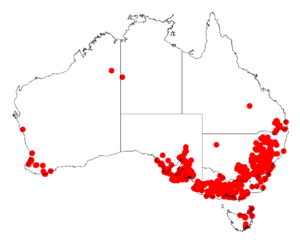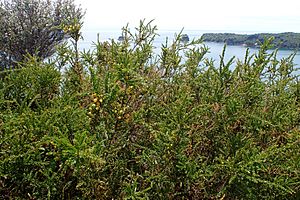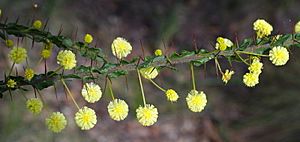Acacia paradoxa facts for kids
Quick facts for kids Kangaroo Thorn |
|
|---|---|
 |
|
| Scientific classification | |
| Genus: |
Acacia
|
| Species: |
paradoxa
|
 |
|
| Occurrence data from AVH | |
| Synonyms | |
|
Acacia armata R.Br. |
|
Acacia paradoxa is a cool plant that belongs to the pea family, called Fabaceae. You might know it by its common names like kangaroo acacia, kangaroo thorn, prickly wattle, hedge wattle, or paradox acacia.
Contents
What it Looks Like
The Kangaroo Thorn is usually a large bush or a small tree. It can grow up to 2 to 4 meters (about 6 to 13 feet) tall and just as wide. Its branches often curve downwards.
What look like leaves are actually special flattened stems called phyllodes. These phyllodes are crinkly, and new ones are often covered in soft hairs. They stand upright and have an uneven, spear-like shape. They are about 30 millimeters (1.2 inches) long and 7 millimeters (0.3 inches) wide.
This plant is also covered in long, sharp spines! It usually blooms between August and November. Its flowers are small, bright yellow, and shaped like little balls. After flowering, it produces brown pods that are 4 to 7 centimeters (1.6 to 2.8 inches) long. Inside these pods are hard, black, oblong seeds, about 6 millimeters (0.24 inches) long.
The sharp, spiny parts called stipules grow at the base of the phyllodes. These spines help protect the plant by stopping animals from eating its leaves.
How it's Named and Classified
The scientific name for plants is part of a system called taxonomy. This system helps scientists organize and name all living things.
The Kangaroo Thorn was first officially described by a botanist named Augustin Pyramus de Candolle in 1813. The name paradoxa comes from two Greek words: para, meaning "near," and doxa, meaning "glory." This name might seem a bit strange for a thorny plant, but it probably refers to how beautiful and showy it looks when it's covered in bright yellow flowers.
This plant has had many other scientific names over time, which are called synonyms. Some of these include Acacia ornithophora, Acacia undulata, Mimosa paradoxa, Racosperma paradoxum, Acacia armata, and Acacia hybrida.
Where it Grows
Kangaroo Thorn is found all over Australia. It can grow back from its seeds after things like bush fires. This plant is very important for local wildlife. Small birds, like wrens, use it for shelter and a safe place to live. Many insects, including moths and butterflies, rely on it for food, and birds also eat its seeds.
It naturally grows in the southeastern parts of South Australia, most of Victoria, eastern New South Wales, and southeastern Queensland. It has also started growing on its own in parts of Western Australia and Tasmania, even though it wasn't originally from there. When a plant starts growing in a new area where it wasn't native, it's called "naturalised."
The plant has also been brought to other continents. In the United States, especially in California, Kangaroo Thorn is known as a noxious weed. This means it can grow very quickly and take over areas, sometimes causing problems for other plants.
Growing Kangaroo Thorn
People often grow Kangaroo Thorn as an ornamental plant because it looks nice. It can also be planted to create a dense screen, which is great for privacy. It provides excellent habitat and food for birds.
This plant grows well in full sun or in a spot that gets some shade. It prefers soil that drains well, whether it's dry or a bit moist. If you want to plant its seeds, they usually need a special treatment called scarification. This means gently scratching or nicking the hard seed coat to help water get in, so the seed can sprout.
See also
 In Spanish: Acacia paradoxa para niños
In Spanish: Acacia paradoxa para niños




